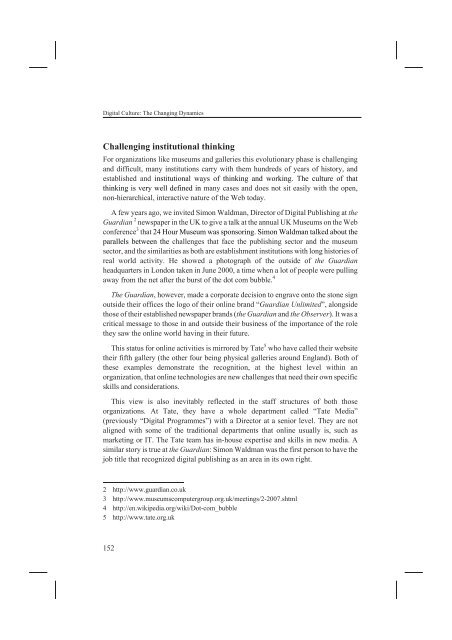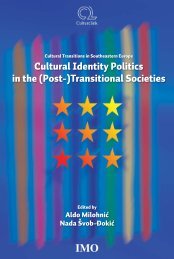D:\Documents and Settings\Ana\My Documents\Biserka-knjiga ...
D:\Documents and Settings\Ana\My Documents\Biserka-knjiga ...
D:\Documents and Settings\Ana\My Documents\Biserka-knjiga ...
Create successful ePaper yourself
Turn your PDF publications into a flip-book with our unique Google optimized e-Paper software.
Digital Culture: The Changing Dynamics<br />
Challenging institutional thinking<br />
For organizations like museums <strong>and</strong> galleries this evolutionary phase is challenging<br />
<strong>and</strong> difficult, many institutions carry with them hundreds of years of history, <strong>and</strong><br />
established <strong>and</strong> institutional ways of thinking <strong>and</strong> working. The culture of that<br />
thinking is very well defined in many cases <strong>and</strong> does not sit easily with the open,<br />
non-hierarchical, interactive nature of the Web today.<br />
A few years ago, we invited Simon Waldman, Director of Digital Publishing at the<br />
Guardian 2 newspaper in the UK to give a talk at the annual UK Museums on the Web<br />
conference 3 that 24 Hour Museum was sponsoring. Simon Waldman talked about the<br />
parallels between the challenges that face the publishing sector <strong>and</strong> the museum<br />
sector, <strong>and</strong> the similarities as both are establishment institutions with long histories of<br />
real world activity. He showed a photograph of the outside of the Guardian<br />
headquarters in London taken in June 2000, a time when a lot of people were pulling<br />
away from the net after the burst of the dot com bubble. 4<br />
The Guardian, however, made a corporate decision to engrave onto the stone sign<br />
outside their offices the logo of their online br<strong>and</strong> “Guardian Unlimited”, alongside<br />
those of their established newspaper br<strong>and</strong>s (the Guardian <strong>and</strong> the Observer). It was a<br />
critical message to those in <strong>and</strong> outside their business of the importance of the role<br />
they saw the online world having in their future.<br />
This status for online activities is mirrored by Tate 5 who have called their website<br />
their fifth gallery (the other four being physical galleries around Engl<strong>and</strong>). Both of<br />
these examples demonstrate the recognition, at the highest level within an<br />
organization, that online technologies are new challenges that need their own specific<br />
skills <strong>and</strong> considerations.<br />
This view is also inevitably reflected in the staff structures of both those<br />
organizations. At Tate, they have a whole department called “Tate Media”<br />
(previously “Digital Programmes”) with a Director at a senior level. They are not<br />
aligned with some of the traditional departments that online usually is, such as<br />
marketing or IT. The Tate team has in-house expertise <strong>and</strong> skills in new media. A<br />
similar story is true at the Guardian: Simon Waldman was the first person to have the<br />
job title that recognized digital publishing as an area in its own right.<br />
2 http://www.guardian.co.uk<br />
3 http://www.museumscomputergroup.org.uk/meetings/2-2007.shtml<br />
4 http://en.wikipedia.org/wiki/Dot-com_bubble<br />
5 http://www.tate.org.uk<br />
152



